|
|
|||||||||||||||||||||
V2_ ORGANISATION, INSTITUTE FOR THE UNSTABLE MEDIA
a conversation between Alex Adriaansens & Nat Muller
Media and technology play an increasingly important role in contemporary society. Communications, production, trade, urbanism, medicine are all being changed by the same technological developments that are transforming the arts. Art that makes use of electronic, especially digital or 'unstable' media, explores the meaning, the specificity and the boundaries of these media. Instability is a creative force which is fundamental to the continuous reorganization of the social, cultural, political and economic relations in our society but which can also be regarded as a deregulating force that disrupts existing social structures. Rather than showing us an orderly and homogeneous world, unstable media present us with an image of the world that is contradictory, heterogeneous and transient.
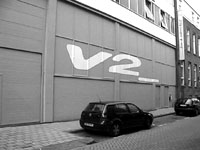
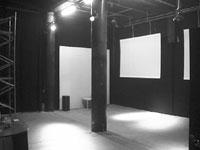

V2_Organisation was founded in 1981 by a group of multi-media artists in 's-Hertogenbosch, and moved to its current location in the center of Rotterdam in 1994, and has since then concentrated on art in electronic networks and on the World Wide Web. V2_ offers a critical perspective on the futuristic promises associated with new media technologies and functions as a platform for debate about the production, distribution and presentation of the art of unstable media. V2_ is interested in the combination of and relations between different media and between different artistic and scientific disciplines. It consistently pursues its research about the relationship between art, technology, the media and society by bringing together artists, researchers, social groups and commercial companies, and by initiating interdisciplinary working relations among them. Over the past fifteen years, V2_ has thus created a continuous dialogue with a wide network of contacts on which it draws for the development of particular art projects.
*
What follow are snippets of an email conversation between Alex Adriaansens (founder and director of V2_) and Nat Muller (events organizer at V2_ since January 2000). As their biographies point out: different generations, different gender, different educational backgrounds: congruous and convergent points of view.
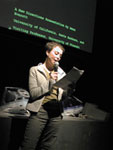 |
|| Nat: I did a close reading of the ‘Manifesto for the Unstable Media’, which was issued by V2_ in 1987, and somehow signified a focusing of the organization on media technology. In a general sense, the manifesto symbolizes for me a critique on ‘traditional’ artistic practice. The usage of technology and electronic media for creative practice has highlighted the disruption of categories like: art discipline, individual authorship, authenticity (whatever that has ever meant), machine as tool, and the whole commodification of art through the system of musea, curators, and conspicuous consumers. For me, the true nature of ‘instability’ lies herein: the continuous pushing and stretching of boundaries and categories we have become accustomed to, the permanent re-thinking and re-inventing of artistic and critical practices, and perhaps most important the generation of the new (however you want to define it). In short, I guess ‘unstable media’ figure as a disturbance engine. | |
| I deliberately use the word engine here, since it combines an aspect of facilitation (as in a steam engine: it gets you places), generation (engines in machine drive the production as it were), and pollution (I don’t mean it in a pejorative sense here, rather more like ‘noise’, ‘disturbance’, ‘disruptions’, the occasional explosion). What do unstable media mean to you, and has it changed over the years? | ||
|| Alex: It is a nice understanding of what instability can mean in the context of media. But for me its not a thing in itself with a straight goal (‘innovation’ as you called it), no I see its meaning going further. Instability for me is inherent for understanding media and more specific for understanding dynamics in all kind of processes (social, cultural, technological). It’s not just meant as an instrument serving a certain purpose, it really is about a basic understanding of social, cultural, technological processes and how these processes can deal with complexity, diversity, dynamics and the ‘accident’ all seen as qualities. This is rather tough as instability indeed also confronts us with the dangerous side of complex processes. This interest for complexity and instability is rather new as these concepts mostly had a negative connotation. Instability refers to the fact that things have to be unstable to be able to transform themselves and processes. As Dick Raaijmakers said: ‘Walking is actually falling.’ When walking one is in a state of instability, so it is a necessity to be able to move around and to interact with our surroundings.
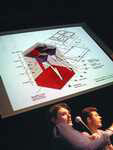 |
|| Nat: V2_Organisation defines itself as an ‘interdisciplinary’ center for art and media technology. Let’s ponder a bit on this notion of interdisciplinarity. Actually this is a question I have been wanting to ask you ever since I started working at V2_, and perhaps have never voiced because of the sheer mundanity. What the hell does interdisciplinary mean? See, my problem with ‘interdisciplinarity’ is that it rides along with other series of fashionable and obligatory buzzwords, such as ‘interactive’, ‘virtual’, etc . . . Just like ‘interactive’ comes to mean most of the time ‘reactive’ (the familiar click here, click there, click everywhere syndrome), ‘interdisciplinary ‘ usually means multi-disciplinary. In other words, you will have an accumulation of different disciplines (audio-visual, video-installation, sound-sculpture, robotic performance). Yet, if the prefix ‘inter’ signifies ‘in-between’ or ‘in the midst of’ rather than many, then in-between which disciplines do we situate ourselves? | |
| Furthermore, doesn’t the term interdisciplinary perpetuate the notion it is actually attempting to combat: re-enforcing the concept of delineated disciplines? Inter-disciplinarity doesn’t seem to accommodate room for new formations of practice/theory really. Shouldn’t we ditch or rethink this concept all together, and define it from material practices, which, if one has to insist on utilising the term ‘discipline’ would be rather trans-disciplinary or meta- or sub-disciplinary. In any case, I think the concept of discipline is far too disciplining and confining, and perhaps it is more useful to have a look at practices in relation to new media: those of artists, but also those of audiences, theorists and organizations. Then, whatever way we choose to define ourselves will be rooted in a situated knowledge of the field. Stemming from the notion that any usage or practice involving technology/art is not created/exercised within a void, but localized within specific geographic, socio-economic, and political contexts. So, Alex, let’s throw away this utterly meaningless term ‘interdisciplinarity’ or give me a good reason why we should keep it. Just to throw more oil on the fire: I think what we do in our practices is countering the black-boxing of technology and creative practice. What ‘interdisciplinarity’ does is pure black-boxing, since the term means actually nothing; it’s just a pleasant-sounding hollow signifier. PLEASE, straighten out my semiotics here ; ) | ||
|| Alex: ‘interdisciplinarity’: referring to different kinds of sciences and disciplines (Kramer’s dictionary)
In the modernist sense of the word interdisciplinarity means some sort of contaminated practice: a practice that is not purely disciplinary, but which is derived from and leans on the vocabulary and methodologies of different disciplines, and by corollary generates an own vocabulary and practice. This is how V2_ approaches interdisciplinarity. The way this is developed is always subject to change and debate.
The placing of interdisciplinary practice within V2_ vis a vis traditional disciplines is awkward, since it is different for every project. I do not see how I could clearly situate the interdisciplinary practice of V2_ topologically. It is not so important whether sometimes it is closer or further away from a known discipline, or in between or around it. It all stems from a hybridization and migration of practices. This hybridization and migration – which features prominently in media technology – is opposed to an extreme specialization which we have witnessed the past century, and which always had an introverted quality. The latter is also true for the language utilized within specialist practices. In short, behavior leading to hermetic systems ought to rethink itself and develop new relations and connections.
To dismiss ‘interdisciplinarity’ as a term because it is over-used or because it is subjected to inflation appears to be inadequate and in fact says more about the problems of language in relation to practice, than strengthening your argument on a content level. I always try to understand as well as I can what people mean by interdisciplinarity when they talk about it, and especially how they make it explicit in their work. Whether terms are a fashion fad or do the right job is another point of conversation. The whole terminology game of trans-, inter-, meta-, and sub-disciplinary is nice as an exercise in discourse, but not really practical. So despite the fact that I agree with you that notions like interdisciplinarity are difficult to maintain and cause misunderstandings, it is not necessarily the case that a new terminology will clear the skies. Nevertheless, the discussion about terminology and discursive frameworks is an important one. In 1996 we organized a debate on the topic with several people from within the arts and media, and made it part of our culture, though it appears that for you this is still going too slow or is not visible enough. That’s why – for the past few years – we have seen it as our goal to make explicit notions such as ‘interdisciplinarity’ and ‘interactive’, and thus to infuse them with meaning and content (there are quite a few V2_ texts and publications which testify to the latter). So, I wouldn’t call for a declaration of the obsolescence of certain notions, on the contrary, one has to give them specific meaning through texts and projects. So that’s why I think interdisciplinarity is for me less of a problem than for you. I can still give it a meaning, while you cannot anymore. Also, for me it is less an epistemological question when speaking of interdisciplinarity, but rather a continuous conversation around practices and notions which are in motion.
(aside from Nat: I guess both Alex and myself agree on the same things here, in the sense that we are both more interested in the embodiment of a notion, that is the practice of something. Still, my literary background comes back to haunt me, the continuous battle between the word and the deed. I would like them adequately integrated somehow.)
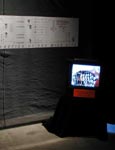 |
|| Nat: Over the past few years, especially after inception of the V2_lab in 1998, V2_ has grown almost 500% in terms of people working for the organization. There are currently 25 people employed by V2_; that is quite substantial for a cultural organization. So I would like to exchange some thoughts on institutionalization. I somehow always read ‘Institute for Unstable Media’ as an ironic aside, a critical sneer towards the lethargy and inertia of the traditional bodies of art, encapsulated in the brick and mortar of musea, galeries, art funds, and yes…even in the bodies of curators, who become institutions upon themselves. Nevertheless, one cannot deny that over the years V2_ has established a leading role within the digital art world, and is working closely together with institutions such as Ars Electronica, and ZKM. So, I guess I am asking: does size matter?! Perhaps you can point out the advantages and the drawbacks (if any) of growing so rapidly into a larger entity. in addition: what is the story behind ‘institution’; and how do you view institutionalization? Is it happening with V2_ somehow, is that good, bad, or malleable? | |
|| Alex: Let me get some facts straight before your numbers cause any further confusion. With the inception of the V2_lab, 3 years ago, 6 extra people were hired for the lab. Since 1998 we hired 6 to 7 extra people, who used to before work for us on a project-base. So actually V2_ grew since 1998 100% (not 500%!) in terms of employees.
V2_ didn’t grow very fast, rather gradually, and only once with a boom, since its move to Rotterdam. The desire to found a media lab existed already for years: a media center without a Research & Development department is like a one-legged person. So the media lab had to come, and therefore fitted almost organically within the organization … it was only a matter of time. It has never been the growth of the organization itself that was problematic, but rather the bad relationship between structural means and project money which made it impossible to tune the organization adequately to its growth. The latter causes specific problems such as continuity in certain areas in the organization, the sustainability of expertise which people gather, etc. V2_ has always been conscious about size, since it always has and in the future aims to have a flat hierarchical structure. This can only be the case if you don’t have too many people working for the organization. The more people you get, the more specialists you get, since usually they are hired to perform specific tasks and functions. By corollary, mobility decreases. The oldies were omnivores in that sense, doing all kinds of tasks, and thus having a different relationship with the organization than the newcomers (specialists).
Once you start getting more than 25 – 30 people in an organization it becomes increasingly difficult to maintain a horizontal structure: naturally you get more divisions of tasks and responsibility, and hierarchical layers. We made the conscious decision that 25-30 people should be the maximum number of people working at V2_, unless people want to take completely different directions or a new management will be installed. I think these possibilities remain open. So, despite the fact that the organization has become more differentiated and responsibilities have been more sharply delineated, there is still a flat hierarchy and lots of room for every individual working here.
You could say that V2_ has made a choice to become an institute with a limited size. Whether it ‘institutionalizes’ as an organization is a different question. We planned a certain size and a certain organizational structure which aims to counter the negative effects of institutionalization. Obviously this is something you cannot simply prevent, but it is very dependent on the people who work there, and how they work and develop. So one has to remain alert. Considering the turbulence at V2_ during the past 7 years, there hasn’t been a moment of rest for the organization, let alone of 'institutionalisation.' So V2_ is an institute, an institute for unstable media that wants to take a certain responsibility and contribute strongly to a local, national and international development in media culture. It’s an organization which will – hopefully – be able to take it easier in the coming years, so that external factors (politics, money, technology) will become less binding for its further development. In this scenario, more time and attention could be invested in our programmers and in the overall structure of the organization.
|| Nat: As we grow as an organization, aren’t we becoming more vulnerable to the 3 Ps: Pressure to Perform, Perpetuate and Preserve? What are the implications for how we function and for our audiences?
|| Alex: Certainly…The larger an organization, the more money is pumped into. This is a result of – to a large extent – public funds and politics. Obviously, there are certain conditions to be met here. One of them is audience accessibility. In politics the demand to cater to larger and more diverse audiences has become increasingly more important. This doesn’t exactly make life easy for us, since many of our activities – on all their different levels - concentrate on research. Furthermore, often there is this tendency to attribute certain functions and tasks to organizations of a specific size. For example: education and collecting. For an organization like V2_ it is not so self-evident to meet these terms, because of its specific character. V2_ has always profiled itself (inter)nationally as an organization with a strong research quality, and we know how fruitful that has been. So I guess that the pressure of the 3 Ps is quite manageable. Nevertheless, you are right that in a more general sense V2_ has a larger responsibility towards the public, but this need not be limiting. In fact it is challenging. The pressure to perform qualitatively at maximum level is high, as is the pressure to secure continuity without always having the means. Nevertheless, I have always had the impression that V2_ is always its own biggest critic.
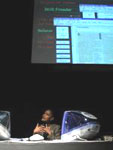 |
|| Nat: I guess, it’s silly to have this conversation without reflecting on the subject of Las Palmas. For over 2 years V2_ had been involved in negotiations about setting up an international center for visual culture and media technology in Rotterdam (in the warehouse Las Palmas) together with the Photo Institutes in Rotterdam (Netherlands Photo Institute, Netherlands Photo Restoration Atelier, Netherlands Photo Archive). Ever since I can remember, these negotiations have been difficult and bumpy, culminating in a total collapse of the initiative in September. Can you shortly describe the incentive of Las Palmas, and its demise? Also, from the outset, Las Palmas seemed to me a very political construction, initiated and pushed by the Minister of Culture and the City of Rotterdam – correct me if I am wrong. Which would provide the city of Rotterdam a particular cultural profiling, as the ZKM provides the city of Karlsruhe, for example. | |
| Can politics ever be a solid basis for cultural enterprises, and conversely, can cultural practices, which somehow become co-opted into political schemes, and whether they like it or not dependent on city or governmental policies, ever maintain their critical, and radical perspectives. Probably I am greatly over-simplifying matters here, but I do this partly to provoke. | ||
|| Alex: The Las Palmas project was an initiative from several organizations including V2_. It didn’t start as a project by politicians. Of course it was clear that it was an interesting project for policy makers as it wanted to relate to the whole range of technical media like cinema, photography and digital media. We also knew that the practices and relations of the participating organizations towards media were quite different, but we wanted to see if we could develop a model that could deal with these facts. So it wasn’t strange that we had to talk a lot with each other and that we came into conflict at certain moments. The biggest trouble we nevertheless encountered was the fact that these debates on different media practices were enlarged on a political level (boards, local and national politics) and made it impossible in the end to agree on the concept of the organization and the organizational structure. Las Palmas was looking for the moments of convergence and divergence between media and other practices. It wanted to focus on the interferences between media and how media were intervening in the practices of different disciplines. V2_ defined Las Palmas as a connection machine that developed its practice by collaborating with different specialisms. Interdisciplinarity was formulated here within the concept of a connection machine.
When one would ask me if politics can be a solid basis for a cultural enterprise I would bounce the question as what is the real question here? The question of politics in relation to art and culture has always been a relation of friction as both have different agendas. As an organization that gets support from public money one has to relate to local, national and international politics and this isn’t bad at all. For the Las Palmas project it became a major obstacle as the partners in this project weren’t able to define a strong common concept which made it possible for politics to intervene with a different agenda.
|| Nat: Taking a look at the V2_archive online, as well as on the shelves of our media archive, the publications, etc etc. V2_ boasts a very impressive list of artists, theorists, activists, performers and so forth. I mean, almost everybody, everything has been at V2_! Whew! What is next? I mean, where’s the exciting, innovative, new stuff at for you at this current moment?
|| Alex: Since the 21 years I’ve been at V2_ I must say that the last decades are defined by all kind of social, technological, cultural and political transformations. Artists, and specifically artists in the field of media technology and their practices, are part of these transformations. We made strong alliances with different groups in society to redefine their practices and role in a broader cultural and social context. I never experienced this as looking for new developments, to be new and present new work. This is more for the musea that became part of a market economy in which new products are a necessity.
The range of questions that have been positioned in the last decades are about very basic things like:
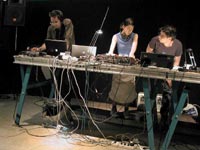 |
> Can we still rely on the definitions of art that were put in place in the last century? If not, what has changed and with what has it been replaced? > It seems that art migrated to different domains in society, if so what does this mean for the arts and its practices? > If we have less interest in objects and more in processes what does this imply for art practices? For example what does interactivity really mean in this context? And what constitutes the artwork? |
|
One knows all these questions and one also knows that we just touched on some of the implications of these transformations. I would say that we will be surprised during the coming years to see what will come out of all of this. We still have to research and build on these practices for the years to come. All your mentioned difficulties with words such as interdisciplinarity and interactivity, and that they mean nothing for you, are just starting to be discovered and given meaning in art practices. Finding the right vocabulary and models is something that will occupy us for the coming years, I guess, and this through all kind of projects that artists, scientists and interdisciplinary collaborations will show us.
I’m realy looking forward to the years to come, not to just see just new things, but to see the deepening of some of the concepts that are defined today. The fact that old concepts are under fire forces us to rethink our position and practices while being aware that some of the proposed models are just the old ones, and this is what I like most about contemporary practices.
Photocredits: Jan Sprij.
about Alex Adriaansens & Nat Muller >>